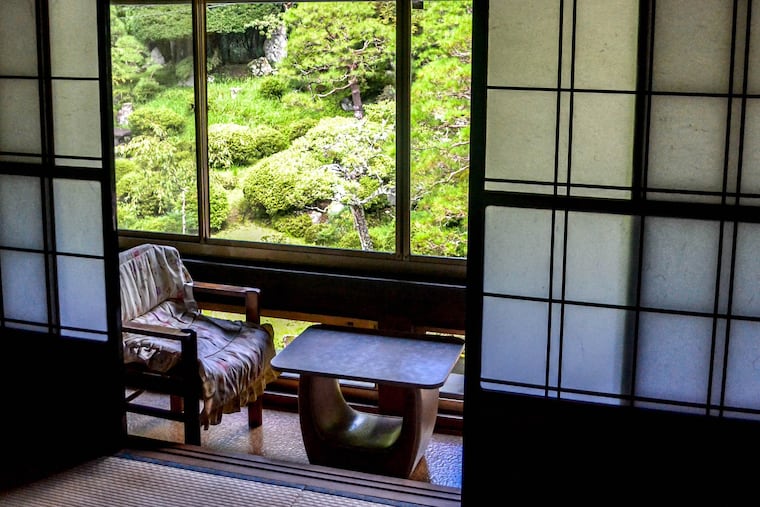Staying in a traditional Japanese temple is not at all a traditional experience
As soon as you take your shoes off at the entrance, your focus shifts from the chaos of your own life to the beauty and calm of the temple. A sense of peace falls over you and lingers throughout your stay.

A typical visit to Japan for many tourists consists of a few days in Tokyo, a train over to Kyoto, maybe Osaka. You stay in a hotel full of amenities, or, if you're on a budget, you might be staying in a capsule hotel or hostel.
That trip would be incredible. You'd learn about the country's most prominent cities, eat and drink amazing things, and inevitably start planning your next trip back in your head on the way home.
But for an off-the-beaten-path travel experience in Japan, consider the shukubo.
A shukubo is a Buddhist temple in Japan that hosts travelers overnight. Traditionally, temples in Japan have welcomed travelers visiting for religious reasons. Pilgrims have long enjoyed retreating to temple stays for days or more, spending time praying, copying religious scripture, hiking, and meditating.
Today, the temple stay is appealing to a new demographic of travelers. Regardless of religious or cultural background, the experience can be transformative.
It begins when you take off your shoes at the entrance. Your focus shifts from the chaos of your own life to the beauty and calm of the temple. A sense of peace falls over you and lingers throughout your stay.
When you stay in a hotel or Airbnb, the attraction is the city around you. At a temple, the accommodation is the attraction. There's joy in wandering the halls, walking around the property, and taking part in routines normally reserved for monks and priests, like copying sutras (Buddhist scripture) as a mindfulness activity and eating shojin ryori vegetarian cuisine.
Then there’s the serenity of a traditional Japanese environment. The sound of sliding back the wooden door to your tatami-mat room becomes ASMR (autonomous sensory meridian response). Soaking in the large, often communal baths makes luxury out of something normally routine.
The internet has helped the shukubo renaissance. Last year, a website was launched for the Terahaku (or temple stay) project, an effort to make this form of lodging more accessible by putting them online. (The website is not in English.)
The project started with 100 options, like the 1,300-year-old Mii-dera shukubo in Shiga Prefecture, but the goal is to list 1,000 over the course of three years.
There are ways to book a temple stay outside of the Terahaku project, too. The Koyasan Shukubo Association built a website to promote its temple stays in the Koya region of Wakayama Prefecture. Some shukubo take marketing into their own hands by creating English-language websites and putting their accommodations on Booking.com, Airbnb, and Japanican.com.
Located in Minobusan — a mountain village in Yamanashi Prefecture — Kakurinbo has been around for 550 years, making it one of the oldest in the region. If you’re coming from Tokyo, there are express buses that take you right up to the village (about 3½ hours and $30). From the last Minobusan bus stop, it’s a 10-minute walk to this shukubo. You can also take the train from Tokyo to Minobu Station (3 hours, $60), where you’d get a taxi cab to take you into the mountains and directly to the temple.
Kakurinbo is run by husband-and-wife-owners Zeryo and Junko Higuchi. (Zeryo is the temple's priest.) Since moving into Kakurinbo in the 1990s after marrying Zeryo, Junko has mostly welcomed Japanese guests. Five years ago, a couple of Swedish cyclists stumbled on their shukubo by happenstance, inspiring Junko to seek more foreign guests. She put Kakurinbo online, hired students to make a foreigner-friendly brochure and map of the area, and created Airbnb Experiences to attract day-trip customers in addition to overnight ones.
Junko is trying to revitalize Minobusan. The town's population has dwindled in the past few decades, and despite being one of Japan's most important religious areas, Minobusan gets left out of most guidebooks. Junko hopes tourism will help breathe new life into the village.
And for a town snubbed by guidebooks, there's a lot going on in Minobusan for travelers.
Up the road from Kakurinbo is Minobusan Kuonji Temple, the most important pilgrimage site for devotees of Nichiren Buddhism. Visitors can walk the 287 stone Steps to Enlightenment, ending up at the stunning structures that make up this temple, more than 700 years old.
There are two prayer ceremonies open to visitors daily — one at dawn and one in the late afternoon. The chants of the monks and the deafening beating of drums are thundering contrasts to the tranquil setting. From the temple, you can take a ropeway up the sacred Mount Minobu to Okuno-in Station, a viewing point where you can see Mount Fuji, depending on the time of year.
Minobusan is in the prefecture known for its wine and fruit. Junko travels to Tokyo each month to learn cooking techniques from a master chef, taking the skills back to the Kakurinbo kitchen, where she plans ornate meals of vegetarian fine dining.
And eating is perhaps one of the most memorable aspects of the shukubo stay for Kakurinbo guests. Reviewers gush over Junko’s artful kaiseki lunches and dinners. Junko’s food changes seasonally and highlights the bounty of Yamagata’s local ingredients, like a frozen plum orb balanced in a bowl of yogurt — a dish made to look like the Japanese flag — or dinner’s preparation of yuba tofu four different ways.